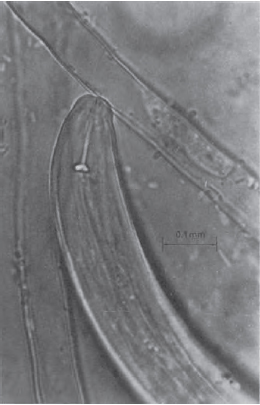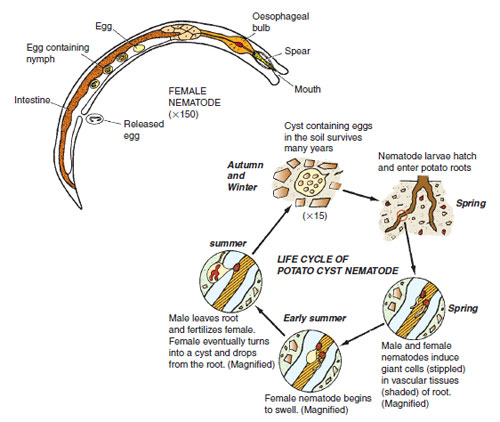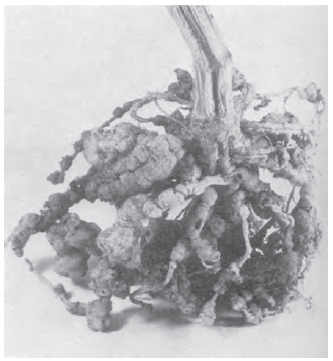Nematode pests
Content
This group of organisms, also called eelworms, is found in almost every part of the terrestrial environment, and range in size from the large animal parasites, e.g. Ascaris (about 20 cm long) in livestock, to the tiny soil-inhabiting species (about 0.5 mm long). Non-parasitic species may be beneficial, feeding on plant remains and soil bacteria, and helping in the formation of humus. The general structure of the nematode body is shown in Figure 14.28. A feature of the plant parasitic species is the spear in the mouth region, which is thrust into plant cells. Salivary enzymes are then injected into the plant and the plant juices sucked into the nematode (see Figure 14.27). Nematodes are very active animals, moving in a wriggling fashion in soil moisture films, most actively when the soil is at field capacity, and more slowly as the soil either waterlogs or dries out. Five horticulturally important types are described below. Potato cyst nematode (Globodera rostochiensis and G. pallida) Damage: This serious pest is found in most soils that have grown potatoes. Leaves become yellow and plants become stunted (see Figure 14.29 ) and occasionally die. The distribution of damage in the field is characteristically in patches. Tomatoes grown in greenhouses and outdoors may be similarly affected. The pest may be diagnosed in the field by the tiny, mature white or yellow females seen on the potato roots (a hand-lens is useful for this observation). Life cycle. A proportion of the eggs in the soil hatch in spring, stimulated by chemicals produced in potato roots. The larvae invade the roots, disturbing translocation in xylem and phloem tissues, and sucking up plant cell contents. When the adult male and female nematodes are fully developed, they migrate to the outside of the root, and the now swollen female leaves only her head inserted in the plant tissues (see Figure 14.28). After fertilization, the white female swells and becomes almost spherical, about 0.5 mm in size, and contains 200–600 eggs. As the potato crop reaches harvest, the female changes colour. In G. rostochiensis (the golden nematode), the change is from white to yellow and then to dark brown, while in the other species, G. pallida , no yellow phase is seen. The significance of the species difference is seen in its control. Eventually the dark-brown female dies and falls into the soil. This stage, which looks like a minute brown onion, is called the cyst, and the eggs inside this protective shell may survive for 10 years or more.
Control: Several forms of control are available against this pest. Since it attacks only potatoes and tomatoes, rotation is a reliable way of overcoming the problem. It has been found that an average soil population of 10 cysts per 100 gm of soil results in about 3 t/ha decline in yield. Thus a soil count for cysts can indicate to a grower (or gardener) whether a field or plot should be used for a potato crop. Early cultivars of potatoes are lifted before most nematodes have reached the cyst stage, and thus escape serious damage. Some potato cultivars, such as ‘Pentland Javelin’ and ‘Maris Piper’, are resistant to golden nematode strains found in Great Britain, but not to G. pallida. Since the golden nematode is dominant in the south of England, use of resistant cultivars has proved effective in this region. There is no chemical control for the Amateur gardener, but the professional grower may use a residual chemical such as oxamyl, incorporated as granules into the soil at planting time. This provides economical control when the nematode levels are moderate to fairly high, but is not recommended at low levels because it is uneconomic, or at high levels because the chemical kills insufficient nematodes. Stem and bulb eelworm (Ditylenchus dipsaci) Damage: The damage caused by this species varies with the crop attacked. Onions show a loose puffy appearance (called bloat); carrots have a dry mealy rot; the stems of beans are swollen and distorted. Narcissus bulbs show brown rings when cut across and their leaves show raised yellow streaks. Life cycle: This species attacks many plants, e.g. narcissus, onions, beans and strawberries. Several strains are known, but their host ranges are not fully defined. The 1 mm long nematodes enter plant material and breed continuously, often with thousands of individuals in one plant. When an infected plant matures, the nematodes dry out in large numbers, appearing as white fluffy eelworm wool that may survive for several years in the soil. Weeds, such as bindweed, chickweed and speedwells, act as alternate hosts to the pest. Spread. This pest spreads mainly in infested planting material. Control is achieved in several ways. Control of weeds (see chickweed); rotation with resistant crops, e.g. lettuce, brassicas (and cereals in commercial bulb growing areas); use of clean, nematode-free seed in onions; warm-water treatment (see Plant protection) onions and narcissus at precisely controlled temperatures. All these methods help reduce this serious pest. Chrysanthemum eelworm (Aphelenchoides ritzemabosi) Damage: The first symptom is blotching and purpling of the leaves, which spreads and becomes a dead brown, V-shaped area between the veins. The lower leaves are worst affected. When buds are infested, the resulting leaves may be misshapen. In addition to chrysanthemum, this nematode also attacks Saintpaulia and strawberries. Life cycle: Most species of nematode live in the soil. This 1 mm long nematode spends most of its life cycle inside young leaves of the species mentioned above. The adults move along films of water on the surface of the plant, and enter the leaf through the stomata. They breed rapidly, the females laying about 30 eggs, which complete a life cycle in 14 days. During the winter they live as adults in stem tissues, but a few overwinter in the soil. Spread. This pest spreads mainly in infested stools. Control: Greenhouse-grown chrysanthemums are rarely affected, as they are raised from pest-free cuttings. Warm-water treatment of dormant chrysanthemum stools, e.g. at 46°C for 5 min, is very effective for outdoor grown plants. Dispose of all plant debris. Root knot eelworm (Meloidogyne spp.) Damage: This nematode, a very serious pest in tropical areas of the world, can be important in UK glasshouse production. It causes large root galls, up to 4 cm in size on the roots of plants such as chrysanthemum, Begonia , cucumber and tomato, resulting in wilting and poor plant growth. Life cycle: The swollen female lays 300–1000 eggs inside the root and on the root surface. These eggs can survive in root debris for over a year, and are an important source of subsequent infestations. The larvae hatch from the eggs and search for roots, reaching soil depths of 40 cm and surviving in damp soil for several months. On entering the plant, the nematode larvae stimulate the adjoining root cells to enlarge. These cells block movement of water to the root stele (see root structure) , which results in wilting symptom so commonly seen with this pest.
Control: For the amateur, resistant tomato rootstocks, e.g. KVNF, may be used on grafted plants. For the professional, nutrient film and soilless methods of growing reduce the pest’s likely importance in a crop. Partial steam sterilization effectively controls the nematode only if the soil temperature reaches 99°C to a depth of 45 cm. Less stringent sterilization often results in a severe infestation in the next crop. Chemical sterilization of soil with the chemical fumigant metamsodium is effective if a damp seedbed tilth is first prepared. A 2.5 cm layer of clean soil or compost placed around roots of infested plants allows some new root growth. Care should be taken not to transfer infested soil (together with transplants) from one greenhouse to another. Migratory plant nematodes The species of nematodes described above spend most of their life cycle inside plant tissues (endoparasites) . Some species, however, feed only from the outside of the root (ectoparasites) . The dagger nematodes (e.g. Xiphinema diversicaudatum) and needle nematodes (e.g. Longidorus elongatus), which reach lengths of 0.4 and 1.0 cm respectively, attack the young roots of crops such as rose, raspberry and strawberry, and cause stunted growth. In addition, these species transmit the important arabis mosaic on strawberry and tomato black ring on ornamentalviruses, cherries. The nematodes may survive on the roots of a wide variety of weeds. Control is achieved by Professional growers by the injection of a fumigant chemical, e.g. dichloropropene or incorporation of dazomet in fallow soils. |
|||||||||||||||||||||||








